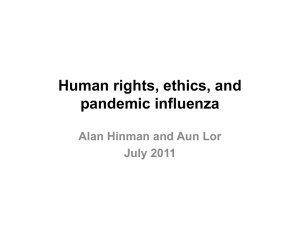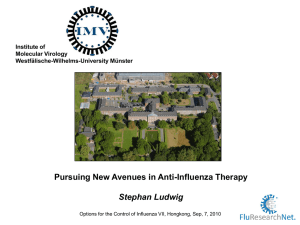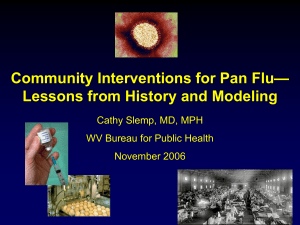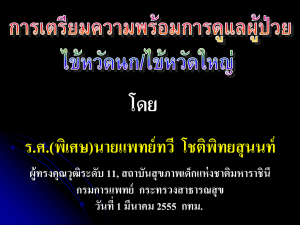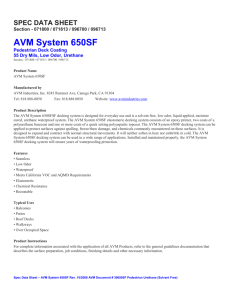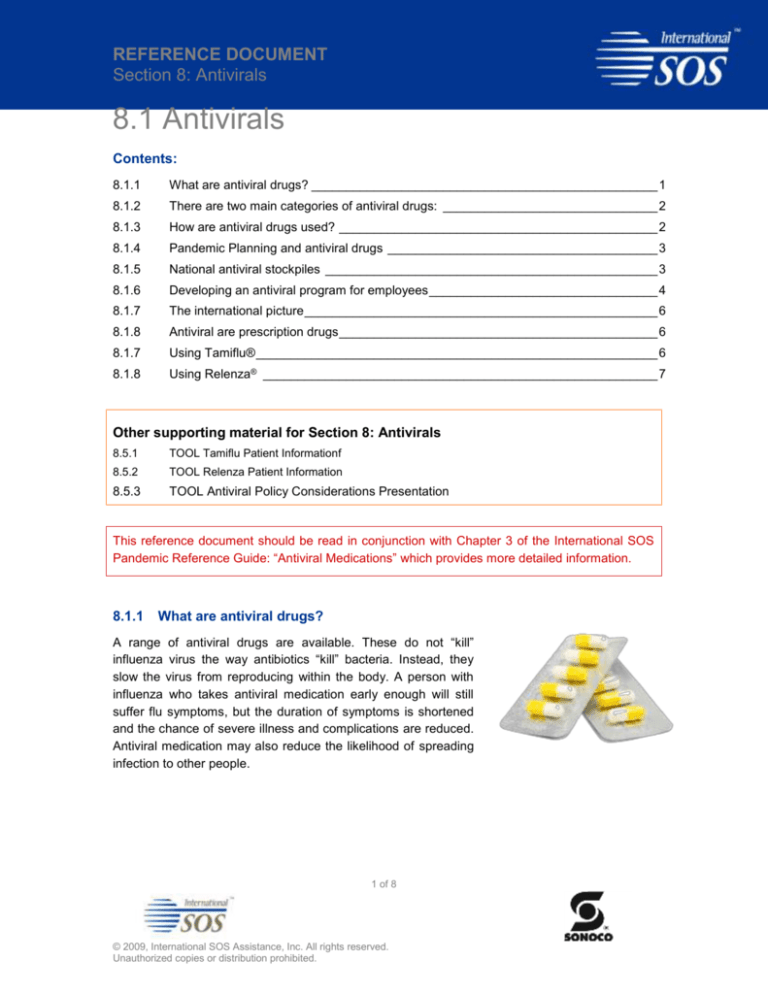
REFERENCE DOCUMENT
Section 8: Antivirals
8.1 Antivirals
Contents:
8.1.1
What are antiviral drugs? __________________________________________________ 1
8.1.2
There are two main categories of antiviral drugs: _______________________________ 2
8.1.3
How are antiviral drugs used? ______________________________________________ 2
8.1.4
Pandemic Planning and antiviral drugs _______________________________________ 3
8.1.5
National antiviral stockpiles ________________________________________________ 3
8.1.6
Developing an antiviral program for employees _________________________________ 4
8.1.7
The international picture ___________________________________________________ 6
8.1.8
Antiviral are prescription drugs ______________________________________________ 6
8.1.7
Using Tamiflu® __________________________________________________________ 6
8.1.8
Using Relenza® _________________________________________________________ 7
Other supporting material for Section 8: Antivirals
8.5.1
TOOL Tamiflu Patient Informationf
8.5.2
TOOL Relenza Patient Information
8.5.3
TOOL Antiviral Policy Considerations Presentation
This reference document should be read in conjunction with Chapter 3 of the International SOS
Pandemic Reference Guide: “Antiviral Medications” which provides more detailed information.
8.1.1
What are antiviral drugs?
A range of antiviral drugs are available. These do not “kill”
influenza virus the way antibiotics “kill” bacteria. Instead, they
slow the virus from reproducing within the body. A person with
influenza who takes antiviral medication early enough will still
suffer flu symptoms, but the duration of symptoms is shortened
and the chance of severe illness and complications are reduced.
Antiviral medication may also reduce the likelihood of spreading
infection to other people.
1 of 8
© 2009, International SOS Assistance, Inc. All rights reserved.
Unauthorized copies or distribution prohibited.
REFERENCE DOCUMENT
Section 8: Antivirals
8.1.2
There are two main categories of antiviral drugs:
1. M2 inhibitors: amantadine and rimantidine
Many influenza A viruses (including some H5N1 and some H1N1 strains) are resistant to
these drugs.
They have significant side effects and hence are not often used unless tightly medically
supervised.
They are included in some national stockpiles
2. Neuraminidase inhibitors: oseltamivir (Tamiflu®) and zanamivir (Relenza®)
They are generally easy to use, with few side effects.
Many national stockpiles include Tamiflu, and some include both Tamiflu and Relenza.
Tamiflu® comes as a capsule and Relenza® is an inhaled powder
8.1.3
How are antiviral drugs used?
Both Tamiflu® and Relenza® can be used for:
1. Treating someone who is sick with influenza
The drug should be started as soon as
possible -ideally, within six hours of the start
of symptoms (definitely within 48 hours of
symptoms, or else they may be ineffective)
2. Post exposure prophylaxis
A smaller dose of the drug is given to
someone has after they have come into
contact with an infected person. This may
prevent the person taking the drug from
becoming sick. The person taking the drugs
can still develop immunity to the flu if they
were infected, even if they do not show
symptoms. The drug is usually continued for
10 days after exposure to the infected person.
2 of 8
© 2009, International SOS Assistance, Inc. All rights reserved.
Unauthorized copies or distribution prohibited.
REFERENCE DOCUMENT
Section 8: Antivirals
3. Long term (pre-exposure) prophylaxis
A smaller dose of the drug is given for up to six weeks to prevent a person from
becoming ill. If that person is exposed to influenza, they may develop immunity
even though they do not become ill.
Antiviral drugs may play a part in an organization’s Pandemic Plan, through either:
The local community healthcare providers and public health agencies – subject to local
guidelines and availability
Privately pre-arranged access to antiviral medications for an organization’s employees (a
company stockpile or other antiviral program)
8.1.4
Pandemic Planning and antiviral drugs
Antiviral drugs should not be used as a single defense mechanism against pandemic influenza.
The medication should be incorporated alongside other interventions (both pharmaceutical and
non-pharmaceutical) as one component of a comprehensive pandemic plan.
The effectiveness of antivirals against the next pandemic influenza is unknown. Influenza is
capable developing resistance to antiviral medication, and some strains are known to currently be
resistant to Tamiflu. Hence the degree to which they may protect an organizations employees is
unknown. The recommended doses for treatment cannot be known ahead of time, and there is a
possibility that they may be in higher amounts than currently used for seasonal flu.
Nevertheless, it is anticipated that the only other pharmaceutical measure to mitigate a flu
pandemic, specific vaccine, will not be available for many months after the pandemic flu strain
emerges.
8.1.5
National antiviral stockpiles
National antiviral stockpiles vary in quantity and the
type being held. Some countries have stockpiled more
than one type of antiviral medication. Some have
enough antiviral medications to provide a “treatment
dose” for up to 50% of their national population.
Others have stockpiled little or no medication.
Use of national stockpiles
In the pre-pandemic and pandemic period,
government authorities tend to use antiviral drugs in a
number of ways:
In an attempt to “contain” an outbreak geographically,
3 of 8
© 2009, International SOS Assistance, Inc. All rights reserved.
Unauthorized copies or distribution prohibited.
REFERENCE DOCUMENT
Section 8: Antivirals
or “delay” spread:
This must be done early in the outbreak
Treatment doses are given to infected persons
Post-exposure prophylaxis doses are given to persons who may have been exposed to
the virus
To “mitigate” the impact:
May be used early in an outbreak, especially if medication is in short supply
May be used after “containment” is no longer feasible, when there is widespread
transmission of the virus
Treatment doses are reserved for those with a severe illness and complications, and for
those at higher risk of severe illness
Post-exposure prophylaxis is limited to contacts who are at higher risk of severe illness
Of course, policies for anitiviral drug use vary widely between countries and governments around
the world. Those with little or no medication stockpiled will not be able to use the drugs widely.
8.1.6
Developing an antiviral program for employees
In the development of an antiviral medication (AVM) program,
consideration must be given to many issues. The policies behind
the program, and the rationale supporting them, should be clearly
documented, to ensure accountability and consistency. The
policies must be accessible as they will need to be reviewed by
other designated persons at a future date.
The following is a suggested checklist of considerations:
The stockpiling of AVM is being considered as, based on
current knowledge, appropriate use of AVM is expected to
reduce the risk and severity of infection among staff.
The stockpiling of AVM is being considered as only one
part of a comprehensive pandemic preparedness plan.
Stockpiling of AVM alone does not adequately prepare
the company against the next influenza pandemic.
Persons responsible for the policy and program:
Are clearly defined
Recognize that the use of AVM is a complex topic and agree to be fully educated
on the topic of influenza and AVMs
Will keep up to date with developing information on influenza and AVM
4 of 8
© 2009, International SOS Assistance, Inc. All rights reserved.
Unauthorized copies or distribution prohibited.
REFERENCE DOCUMENT
Section 8: Antivirals
Understand that AVM may not be effective against the next influenza pandemic,
and that stockpiled AVM may expire prior to it being required
The policies and program are to be reviewed regularly, and updated as required
There is a process to decide on changes to the program
Sources to be consulted for information relating to AVM are defined
Ethical issues will be discussed (AVM is a limited resource, which may be potentially lifesaving)
Legal issues are discussed (consider whether expert advice required), and COMPANY
NAME will follow the legal requirements for AVM in each country of operation
Financial issues are discussed – cost of providing AVM will be more than just the cost of
the AVM alone (additional costs to consider include cost to prescribe and store)
Employees are provided an appropriate education program
Who will be covered under the policy?
All / some staff
All / some dependents
All / some contractors
How will medication be used?
for treatment
pre-exposure prophylaxis
post-exposure prophylaxis
or a combination of the above approaches
The purchase and storage of AVM have been considered. The process should be :
Consistent across the company – where this is not possible, it should be clear
that differences are due to regional requirements
Secure – recognizing that AVM may pose a security issue
Ongoing – what will be done with expired medication? Will it be replenished?
The different methods of distribution are considered, recognizing the benefit and pitfalls
of each method :
Immediate – Requires identification prior to the pandemic of those persons who
are eligible for AVM. The employee is responsible for maintaining proper storage.
Those who leave the company will retain AVM resulting in a loss of AVM and a
need for re-stocking.
5 of 8
© 2009, International SOS Assistance, Inc. All rights reserved.
Unauthorized copies or distribution prohibited.
REFERENCE DOCUMENT
Section 8: Antivirals
At a later date but prior to it being required – the triggers to distribute must be
defined. Requires identification prior to the pandemic of those persons who are
eligible for AVM.
At a later date when it is required– recognizing that there is a risk that the
employee may not receive AVM in a timely fashion.
8.1.7
The international picture
There are strict regulations in place that govern the import and export, purchase, storage,
prescription and distribution of antiviral medications. The medication must be licensed in the
country of intended use. Entities must hold the appropriate licenses to perform any part in the
chain of procedures, (purchase, store, prescribe, dispense) up until the medication is dispensed
to the end user. These regulations vary between countries, and at times even within countries.
The three distribution methods for antiviral medication mentioned above are theoretically
possible. However, in a given location, regulations may permit none, one, two or all three
methods.
8.1.8
Antiviral are prescription drugs
Antivirals are usually available by prescription only, although there are a few exceptions in some
countries. During a pandemic, under special regulations, some countries may allow pharmacists
and nurses to provide antiviral medications to sick persons without requiring a doctor’s
visit/prescription. In addition, public health authorities may issue guidelines for use. Guidelines
may change as the pandemic evolves.
8.1.7
Using Tamiflu®
Tamiflu is available as a 75 mg capsule. Special
formulations (suspension or lower dose capsules)
are available in some regions. Always follow
instructions given by the prescribing doctor, and
refer to the manufacturer’s package insert.
Treatment
The usual adult dose for treatment is one capsule (75mg) twice daily, for 5 days. Dosage is
adjusted for children.
6 of 8
© 2009, International SOS Assistance, Inc. All rights reserved.
Unauthorized copies or distribution prohibited.
REFERENCE DOCUMENT
Section 8: Antivirals
Prophylaxis
Tamiflu® may also be used as prophylaxis, to prevent people from becoming infected either
before or after exposure to influenza. The usual adult dose is one capsule (75mg) once a day, for
10 days following exposure, or for the duration of exposure, up to 6 weeks.
Who should not take Tamiflu®?
Anyone who is allergic to oseltamivir phosphate (the main ingredient), or any of its other
ingredients. It is not usually recommended during pregnancy, breastfeeding, or for children
younger than 1 year, although some guidelines may be changed during a pandemic.
What are some side effects?
Nausea and vomiting occur in about 10% of people taking the medication. This may be less of a
problem if the drug is taken with food. Other side effects can occur. Consult the manufacturer’s
information.
8.1.8
Using Relenza®
Relenza is available as a powder which is inhaled via a
device called a “diskhaler”.
Always follow instructions given by the prescribing doctor,
and refer to the manufacturer’s package insert.
Treatment
The usual dose for treatment for adults and children over 7 years old, is an inhalation of two
“blisters” (10mg) twice daily. The usual treatment course is 5 days. The age at which the drug is
approved for use varies between countries.
Prophylaxis
In some countries, Relenza® may also be used as prophylaxis to prevent infection either before or
after exposure to influenza. The usual preventative dose is an inhalation of two “blisters”
(10mg).once a day, for 10 days following exposure or for the duration of exposure.
Who should not take Relenza®?
Anyone who is allergic to zanamivir (the main ingredient), or its other ingredient, lactose powder
(which contains milk proteins). It is not usually recommended during pregnancy or breastfeeding,
although some guidelines may be changed during a pandemic.
Relenza® is not recommended for people with underlying lung conditions such as asthma or
chronic obstructive airways disease, as it has been known to trigger serious wheeze and
bronchospasm.
What are some side effects?
7 of 8
© 2009, International SOS Assistance, Inc. All rights reserved.
Unauthorized copies or distribution prohibited.
REFERENCE DOCUMENT
Section 8: Antivirals
Nausea, diarrhea, dizziness and headache can occur. Severe reactions of wheezing and
bronchospasm can occur in some people even if they do not have underlying lung disorders
(such as asthma or chronic obstructive airways disease). This severe reaction can be fatal. Other
side effects can occur. Consult the manufacturer’s information.
8 of 8
© 2009, International SOS Assistance, Inc. All rights reserved.
Unauthorized copies or distribution prohibited.


